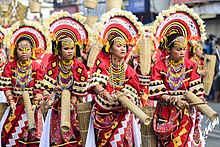
Back Lumad BCL Lumad Catalan Lumad CBK-ZAM Lumad German Pueblos lumades Spanish Lumad ID 루마드족 Korean Lumadi Latvian/Lettish Lumad NB Lumad Tagalog
 | |
| Regions with significant populations | |
|---|---|
Caraga Davao Region Northern Mindanao Soccsksargen Zamboanga Peninsula | |
| Languages | |
| Manobo languages, Mansakan languages, Subanen languages, South Mindanao languages, Cebuano, Hiligaynon, Chavacano, Filipino, English | |
| Religion | |
| Christianity (Roman Catholic, Protestant) Animist & Islam | |
| Related ethnic groups | |
| Sama-Bajau, Moro, Visayans, Filipinos, other Austronesian peoples |
| Demographics of the Philippines |
|---|
 |
| Filipinos |

The Lumad are a group of Austronesian indigenous peoples in the southern Philippines. It is a Cebuano term meaning "native" or "indigenous". The term is short for Katawhang Lumad (Literally: "indigenous people"), the autonym officially adopted by the delegates of the Lumad Mindanao Peoples Federation (LMPF) founding assembly on 26 June 1986 at the Guadalupe Formation Center, Balindog, Kidapawan, Cotabato, Philippines.[1] Usage of the term was accepted in Philippine jurisprudence when President Corazon Aquino signed into law Republic Act 6734, where the word was used in Art. XIII sec. 8(2) to distinguish Lumad ethnic communities from the islands of Mindanao.[2]
Mindanao is home to a substantial part of the country's indigenous population, around 15% of the Philippines' total population of over 100 million.[3]
- ^ Rodil, Rudy B. "The Tri-People Relationship and the Peace Process in Mindanao". Archived from the original on 5 August 2004. Retrieved 21 October 2017.
- ^ Ulindang, Faina. "Lumad in Mindanao". National Commission for Culture and the Arts. Archived from the original on 7 May 2021. Retrieved 18 April 2021.
- ^ National Statistics Office. "Statistics on Filipino Children." Journal of Philippine Statistics, vol. 59, no. 4, 2008, p. 119.
© MMXXIII Rich X Search. We shall prevail. All rights reserved. Rich X Search